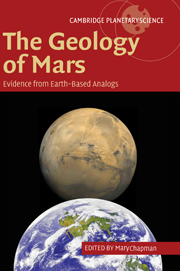Book contents
- Frontmatter
- Contents
- Preface: the rationale for planetary analog studies
- List of contributors
- 1 The geology of Mars: new insights and outstanding questions
- 2 Impact structures on Earth and Mars
- 3 Terrestrial analogs to the calderas of the Tharsis volcanoes on Mars
- 4 Volcanic features of New Mexico analogous to volcanic features on Mars
- 5 Comparison of flood lavas on Earth and Mars
- 6 Rootless volcanic cones in Iceland and on Mars
- 7 Mars interior layered deposits and terrestrial sub-ice volcanoes compared: observations and interpretations of similar geomorphic characteristics
- 8 Lava—sediment interactions on Mars: evidence and consequences
- 9 Eolian dunes and deposits in the western United States as analogs to wind-related features on Mars
- 10 Debris flows in Greenland and on Mars
- 11 Siberian rivers and Martian outflow channels: an analogy
- 12 Formation of valleys and cataclysmic flood channels on Earth and Mars
- 13 Playa environments on Earth: possible analogs for Mars
- 14 Signatures of habitats and life in Earth's high-altitude lakes: clues to Noachian aqueous environments on Mars
- 15 The Canyonlands model for planetary grabens: revised physical basis and implications
- 16 Geochemical analogs and Martian meteorites
- 17 Integrated analog mission design for planetary exploration with humans and robots
- Index
- Plate section
- References
6 - Rootless volcanic cones in Iceland and on Mars
Published online by Cambridge University Press: 18 September 2009
- Frontmatter
- Contents
- Preface: the rationale for planetary analog studies
- List of contributors
- 1 The geology of Mars: new insights and outstanding questions
- 2 Impact structures on Earth and Mars
- 3 Terrestrial analogs to the calderas of the Tharsis volcanoes on Mars
- 4 Volcanic features of New Mexico analogous to volcanic features on Mars
- 5 Comparison of flood lavas on Earth and Mars
- 6 Rootless volcanic cones in Iceland and on Mars
- 7 Mars interior layered deposits and terrestrial sub-ice volcanoes compared: observations and interpretations of similar geomorphic characteristics
- 8 Lava—sediment interactions on Mars: evidence and consequences
- 9 Eolian dunes and deposits in the western United States as analogs to wind-related features on Mars
- 10 Debris flows in Greenland and on Mars
- 11 Siberian rivers and Martian outflow channels: an analogy
- 12 Formation of valleys and cataclysmic flood channels on Earth and Mars
- 13 Playa environments on Earth: possible analogs for Mars
- 14 Signatures of habitats and life in Earth's high-altitude lakes: clues to Noachian aqueous environments on Mars
- 15 The Canyonlands model for planetary grabens: revised physical basis and implications
- 16 Geochemical analogs and Martian meteorites
- 17 Integrated analog mission design for planetary exploration with humans and robots
- Index
- Plate section
- References
Summary
Introduction
In the 1970s, the two Viking spacecraft returned images of the surface of Mars in which numerous small domes, knobs, and mounds were visible. Based on the presence of summit depressions in many of these domes, they were interpreted to be rootless volcanic cones (Frey et al., 1979; Frey and Jarosewich, 1982), by analogy with similar features found in Iceland (Thoroddsen, 1894; Thorarinsson, 1951, 1953). Rootless cones (also called pseudocraters – a literal translation of the Icelandic gervigígar) form as a result of explosive lava–water interaction, whereby a flowing lava encounters a waterlogged substrate, causing violent vaporization of the water and expulsion of the lava from the explosion site (Thorarinsson, 1951, 1953). Repeated explosive pulses build a cone of disintegrated liquid and solid lava debris (Thordarson et al., 1992). As the activity at a given site within the flow wanes, explosions may be initiated elsewhere, leading to construction of a field of tens to hundreds of cones. Although they may bear a superficial resemblance to primary volcanic cones built over a subsurface conduit, Icelandic rootless cones are quite distinct, in that they are surface phreatomagmatic structures formed at the lava–substrate interface (Thordarson, 2000).
The identification of possible rootless cone fields at mid to low latitudes on Mars incited great interest because of the implication for the presence and distribution of volatiles (i.e., water or ice) in the near-surface environment on Mars (Frey et al., 1979; Frey and Jarosewich, 1982).
- Type
- Chapter
- Information
- The Geology of MarsEvidence from Earth-Based Analogs, pp. 151 - 177Publisher: Cambridge University PressPrint publication year: 2007
References
- 37
- Cited by



